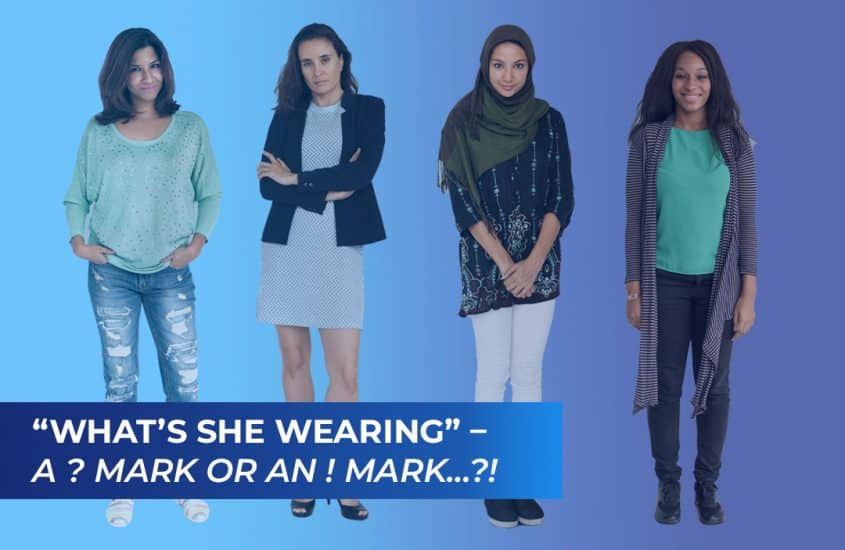“What’s she wearing” – a ? mark or an ! mark…..?!

Author: Vaishnavi Rajan
A lot of you would go, “well, she’s wearing her confidence, kitsch!” To the ones thinking this, I’d say – hell yeah, you go swirl and high!
However, we all know this is not always the case. An individual, especially who is not heterogeneously male, is under routine scrutiny in a professional environment on their outfit of the day (#ootd), or rated based on how they look. More often than not, it’s a negative exclamation – “what is she/they wearing today dude!” Well, isn’t how you dress the easiest damn thing to criticize! One can perceive this hypervisibility as a boon or as a curse. The “one” here being – the wearer. (For the sake of context, I’d like to define this TG as primarily consisting of women, pregnant women, non-binary, and transgender professionals)
The popular negative way of interpreting the exclamation would be unsuitability, fitment, or faux pas of the attire. Or as they popularly like to term as “dressed up inappropriately”. Leading to ridicule, discomfort and awkwardness that stays on like that dry cough post a flu. Leading to the tumour of fear: fear of not being taken seriously at work. Only because of how we chose to look that day.
There is an unexplored, positive way of catching hold of that attention, and wearing it confidently. I call it choices. Unlike the ones who (rather do not) identify themselves as chauvinistically male, we have a lot of options of what we could wear to work. Myriad combinations and curations to experiment with, and be adventurous with how we would like to present ourselves at work. Be daring, be bold, be ourselves genuinely! We choose to embrace these choices of outfits we have, rather than be the same old and boring “trouser and shirt” each and every day! Would it then be okay to change the narrative to “What’s he wearing, again!”
Especially in a profession of sales, and of marketing, it does offer immense ground to play the sport of styling in the outfit game. Primarily because this world provides us exposure to meeting people of different levels of mindsets, backgrounds, and acceptability. Sometimes, we need to fit in the mould of appearing formal. While sometimes, we need to fit in the quirky mould (you know, to show the client that hey, we are creative!). And sometimes, the traditional desi look! This hop-scotching from mould to mould, if you ask me, only makes us look more daring, confident, curious. Doesn’t this mean that we are also willing to be more adaptable? That we are willing to blend in with the brand to work and co-create with them? It makes me wonder, how is experimenting with our workplace wear attracting negative exclamation marks, rather than the curious question of “Wow! What’s she/they wearing?” It’s time to change another narrative.
How do we do it? Especially when we live in such a hypocritical, higgledy-piggledy era. On the one hand, folks are going – don’t wax, be yourself, wear whatever you like, with no distinct fashion trend going on. On the other hand, folks are so addicted to looking good for followers and for likes! In fact, the convenience of being in this generation is that literally EVERYTHING is in fashion. There’s your bell-bottoms, ripple-skirts, boyfriend-shirts-tees-denims, co-ords, hell even pyjamas! If there are pros and cons, let’s follow the pros, no? Can we park aside the cons to be covered with dust forever?
Your style of dressing is your branding.
Mr. Zuckerberg can oftentimes be seen donning the same tee or hoodie. Our late Mr. Steve Jobs was known for his black polo tee. Sri Sri Ravi Shankar always makes his appearances in white. How about Mother Teresa? And the great father of our nation, Mr. Karamchand Gandhi? It wasn’t what they wore that stole the spotlight. It was purely their work, their vision, their creations.
Moral of the story is – wear what gives you a feeling of liberation, and sparks out the spunk out of you! There is no right way of dressing. There’s only a comfortable way of carrying yourself. Nobody has been bestowed with any responsibility of determining what’s appropriate, and what’s not. Just use some logic to why you wear what you wear at work, and the environment you’d be wearing it in. I call this “fashological” sense of styling. And if it does make sense, those glares would have more exclamations of likes and curious question marks.









